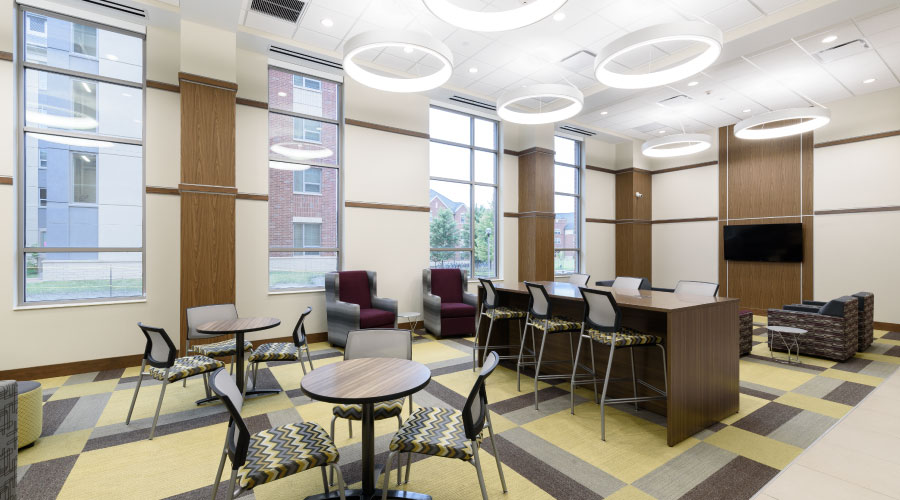Birds and Buildings: Finding Lighting Solutions
Electric lighting for buildings, roadways and parking lots can create problems for migrating birds
By Leora Radetsky and Julia Wang, Contributing Writers
As winter turns into spring, there is one universal harbinger of the new season, regardless of regional climates – the return of abundant daylight. More natural light lifts human spirits, but humans are not the only ones responding to the change. Increased daylight is a primary trigger for bird migration, prompting over 3 billion birds to set off from wintering grounds to breeding areas across the United States and Canada between March and mid-June.
About 70 percent of North American birds are migratory. Of those, around 80 percent travel by night, navigating darkened skies aided by the moon and stars. Since darkness — or more precisely, a lack of light pollution that can overwhelm natural signals — is integral to these biannual journeys, electric lighting for buildings, roadways and parking lots creates problems.
Lighting out of control
Lighting that is misdirected, excessive or improperly located causes light to spill into areas where it is not needed or wanted and scatter across the night sky. Over the past decade, light pollution has accelerated by about 10 percent annually, now obscuring the Milky Way from view for 80 percent of North Americans.
In urban and suburban areas, many office towers, shopping centers and other commercial facilities are unnecessarily lit throughout the night, ostensibly for visibility and security reasons. While this practice is well intentioned, it is hazardous to migrating birds. Light pollution can attract and disorient birds, pulling them toward areas where they are more likely to be exposed to urban and suburban dangers, such as colliding with buildings and other human structures.
Concentrated lighting also can lure birds to circle within a beam of light until they exhaust themselves and fall out of the air, where they are easy prey for cats and other terrestrial predators, or they risk colliding with the buildings around them when they attempt to take off again.
An estimated 365 million to 988 million birds die in collisions with buildings annually in the United States, according to a 2014 review of bird collision studies, and a new 2024 paper suggests the number is likely higher. This situation is particularly troubling against a backdrop of decades of staggering bird losses. Since 1970, nearly one in four birds have vanished.
Taking action
The good news is that increased public awareness is fueling action. Hundreds of cities, towns and counties in the United States and Canada have enacted light pollution laws or ordinances, and 19 states, the District of Columbia and Puerto Rico have adopted laws to mitigate light pollution.
Unlike many other environmental challenges, light pollution can be easily addressed, and the very buildings and facilities that pose potential risks to migrating birds are positioned to contribute greatly to solutions while benefiting from incremental energy savings due to dimming or switching off non-essential lighting.
Dozens of Lights Out campaigns across North America point to suites of simple but critically important solutions proven to reduce and eliminate nighttime lighting hazards for migrating birds. The Cornell Lab of Ornithology, Audubon and other partners encourage building owners and managers to eliminate or reduce non-essential facility lighting that is visible outside, particularly during critical migration periods predicted by the migration forecasting tool BirdCast.
Building managers and other commercial lighting decision makers first should confirm that they are meeting local and state energy and building codes. Many codes already call for turning off or dimming facade and non-essential lighting at night and require dimming or motion sensing for exterior lighting that is deemed essential.
For example, commercial energy efficiency requirements in the International Energy Conservation Code (IECC 2021) mandate that facade and landscape lights be automatically shut off from one hour after building closure to one hour before opening. Other exterior lighting must be reduced by 50 percent or more by dimming or selectively switching off lights during prescribed timeframes.
Likewise, ASHRAE/IES 90.1.2022 contains various requirements for building exteriors during non-operating hours. They include switching off landscape and facade lights and using scheduled dimming or occupancy sensors to dim by at least 50 percent for parking areas, walkways, plazas and entry doors except in certain cases where lighting is needed, such as for safety or security.
Lighting tactics and strategies
Beyond code compliance or in jurisdictions where energy or building codes are not as stringent, here are other strategies to consider.
For building exteriors:
- Extinguish facade lights at night, particularly between 11 p.m. and 6 a.m. during peak migration times, even if the building is occupied.
- If networked lighting controls are in use, create a program that turns off or dims all non-essential lighting during this period.
- Turn off or deeply dim non-essential exterior signage.
It is worth noting that facade and landscape lighting is often used for marketing and prestige. Letting the public know that the lighting will be adjusted during bird migration season is a great opportunity to publicize corporate responsibility and advance the company brand.
Buildings with a great deal of glass look like giant lanterns when illuminated at night, making it essential to also address interior building lighting — ideally, with networked lighting controls:
- Between 11 p.m. and 6 a.m. during peak migration times, turn off or deeply dim non-essential lights inside skylights, and use manual or electronic controls to close curtains and shades to prevent interior light from spilling outside.
- For unoccupied spaces, switch off non-emergency lights, or deeply dim lights that illuminate vertical surfaces while maintaining egress pathway lights.
For exterior spaces such as walkways and landscapes:
- Use light fixtures with lower color temperatures. Correlated color temperatures of 3,000K or lower will reduce light pollution and sky glow.
- Avoid emitting light upwards by installing light fixtures with a backlight, uplight and glare (BUG) rating of U1 or lower and by avoiding tilted mounting structures.
- During unoccupied periods —or one hour after business closes to one hour before opening or from midnight to 6 a.m. — turn off or deeply dim all non-essential landscape lights, and dim essential lights and signage to meet or exceed code requirements.
- Follow the design principles for landscape lighting in ANSI/IES RP-47-23 titled Recommended Practice: Landscape Lighting, which recommends downlighting, using low light levels that are no more than that provided by the full moon — 0.01 footcandles or less — for lighting trees and shrubs, focusing on contrast ratios, switching off non-essential landscape lighting at 11 p.m. or earlier and minimizing obtrusive light and sky glow.
- Dim parking lot light fixtures. Some research shows people report feeling just as safe with area lighting dimmed to 25 percent of full output.
Spotlight on products
The DesignLights Consortium — a non-profit with a mission to reduce energy use, carbon emissions, and light pollution through quality lighting and controls — developed its LUNA technical requirements to provide a dark-sky friendly option for specific categories of outdoor lighting. LUNA’s Qualified Products List enables lighting decision makers to identify products that minimize light pollution and meet energy-saving benchmarks that qualify them for money-saving rebates and incentives from 75 percent of North American energy efficiency programs.
LUNA-listed products also can help facility owners and managers certify compliance with light pollution criteria specified by rating systems such as WELL, LEED and SITES. For example, among the aspects of a building project eligible for LEED certification points is light pollution reduction, with requirements intended “to increase night sky access, improve nighttime visibility and reduce the consequences of development for wildlife and people.”
Similarly, the WELL Building Institute says lighting “should be planned to maximize benefits and to reduce light pollution, light trespass and adverse health outcomes.” Consideration of light at night counts toward certification of spaces and communities that advance health and wellbeing under WBI’s community standards.
Since even the best outdoor lighting products can fail to meet these objectives if not applied correctly, DesignLights also created an online resource, Seven Strategies to Minimize Negative Impacts of Outdoor Light at Night. Outlining application strategies that go beyond the LUNA product requirements, this downloadable resource promotes practices that support outdoor lighting that is both energy efficient and reduces light pollution.
As birds across North America undertake their demanding journeys this spring, now is a perfect time to consider ways to mitigate the challenges light pollution adds to their already long and dangerous flights. Through thoughtful design, minimizing overlighting, selecting the most effective products and implementing controls, facility owners and managers can protect one of North America’s most extraordinary natural spectacles while still preserving the intent and value of outdoor lighting.
Leora Radetsky is LUNA program director and senior lighting scientist for the DesignLights Consortium. Julia Wang is BirdCast project leader for the Cornell Lab of Ornithology.
Related Topics:












